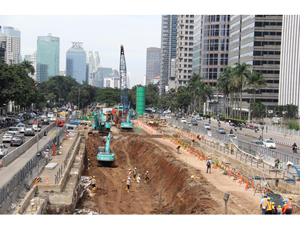In a little more than 18 months, Indonesia’s capital, Jakarta, has become unrecognizable as the $1.8-billion Mass Rapid Transit project continues to cut a deep scar across the city. With 13 stations—seven elevated, six underground—along with a rail depot, the project features the construction of both cut-and-cover and bored tunnels, the latter using tunnel boring machines (TBMs) where space restricts deep excavations. With deep secant pile support and precast segmental pre-stressed viaducts also a feature, the project brings to Indonesia a host of construction technologies rarely seen in the archipelago.
The 23.3-kilometer-long north-south corridor will run between Lebak Bulus in south and Kampung Bandan in north of Jakarta, and is being built in two phases. Phase I consists of 15.2-km rail line from Lebak Bulus to Bundaran HI, where the majority of the working population is concentrated. Some 9.2 km of the rail track will be elevated while 6 km are underground.
The scheme has been eagerly embraced by a majority of the city’s 9 million dwellers. Without it, they face total logjam in the streets thanks to the burden of an estimated 1,000 more vehicles.
Estimated congestion costs the economy some $5 billion per year, while growing traffic causes 80% of all air pollution.
City-owned PT Mass Rapid Transit (MRT) Jakarta, the operator of the MRT project, signed the project contracts in June 2013. Phase I will open in the first quarter of 2018 at the earliest. Delays are already making their mark, with planning approvals proving difficult in one of the region’s most populous countries. The government is clinging to the hope of having the project fully open by 2030.
It is being delivered by two main consortia of Japanese and state-owned companies. Shimizu, Obayashi, Wijaya Karya and Jaya Konstruksi are constructing two underground project packages while Sumitomo Mitsui Construction Co. and PT Hutama Karya make up the other.
The project is being funded by Japan International Cooperation Agency (JICA) to the tune of $1.5 billion, while the national government and city government are picking up 42% and 58%, respectively, of the remainder of the cost.
But the project has been beset by a host of problems, as city and national agencies struggled to acquire the land the project needs and tackle obstacles such as bus stops, electricity substations and, in one case in South Jakarta, a sports stadium.
“We’re working with everyone in good faith,” says Dono Boestami, president director of PT MRT Jakarta. “The mass rapid transit system will not solve all Jakarta’s traffic problems, but it is the first step in the creation of an efficient commuter network.”
Phase II of the project extends the route a further 8.1 km from Bundaran HI to Kampung Bandan. This line is being built completely underground.
An east-west corridor, originally targeted for opening by 2027, is expected to complete by 2030.


Post a comment to this article
Report Abusive Comment